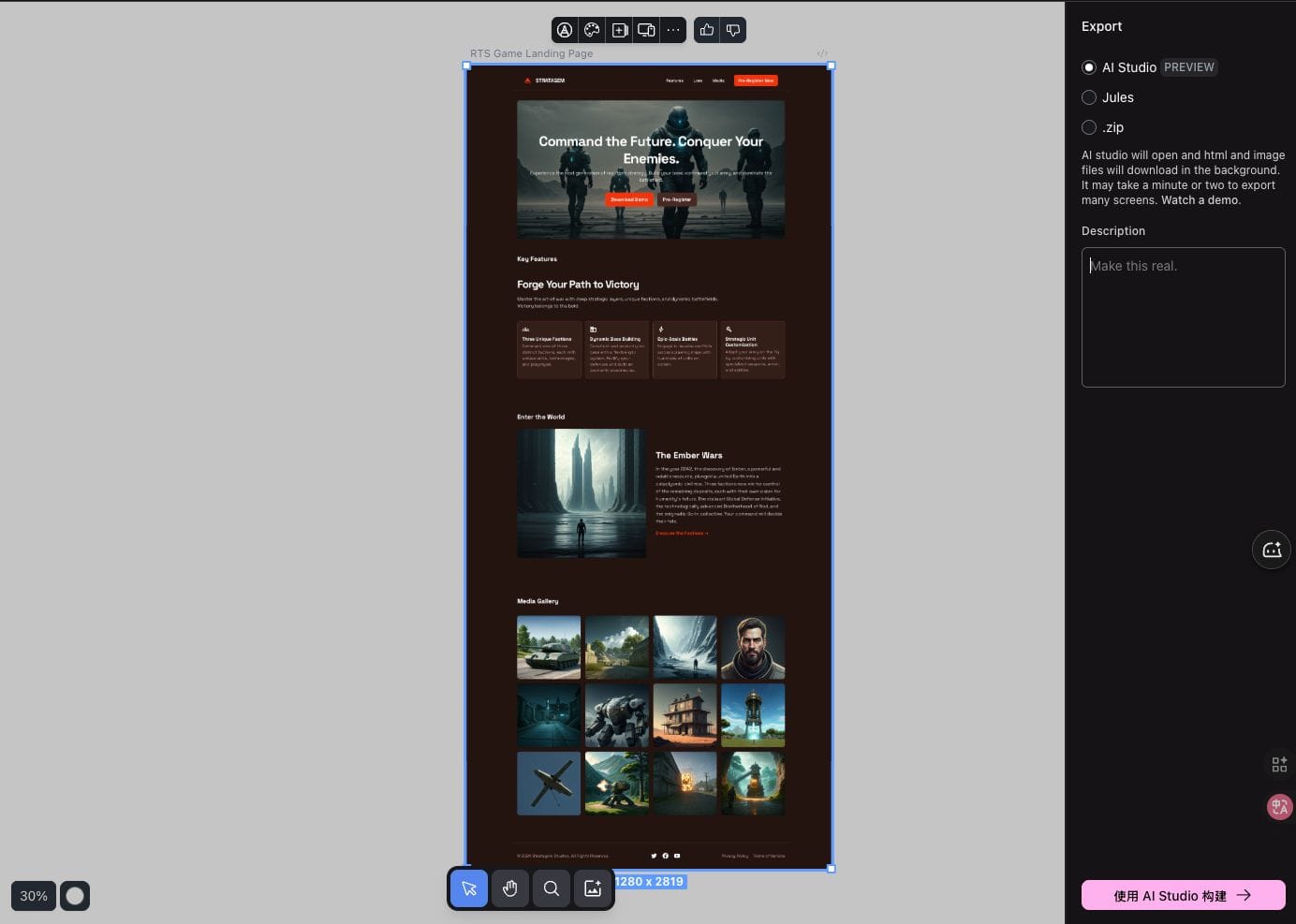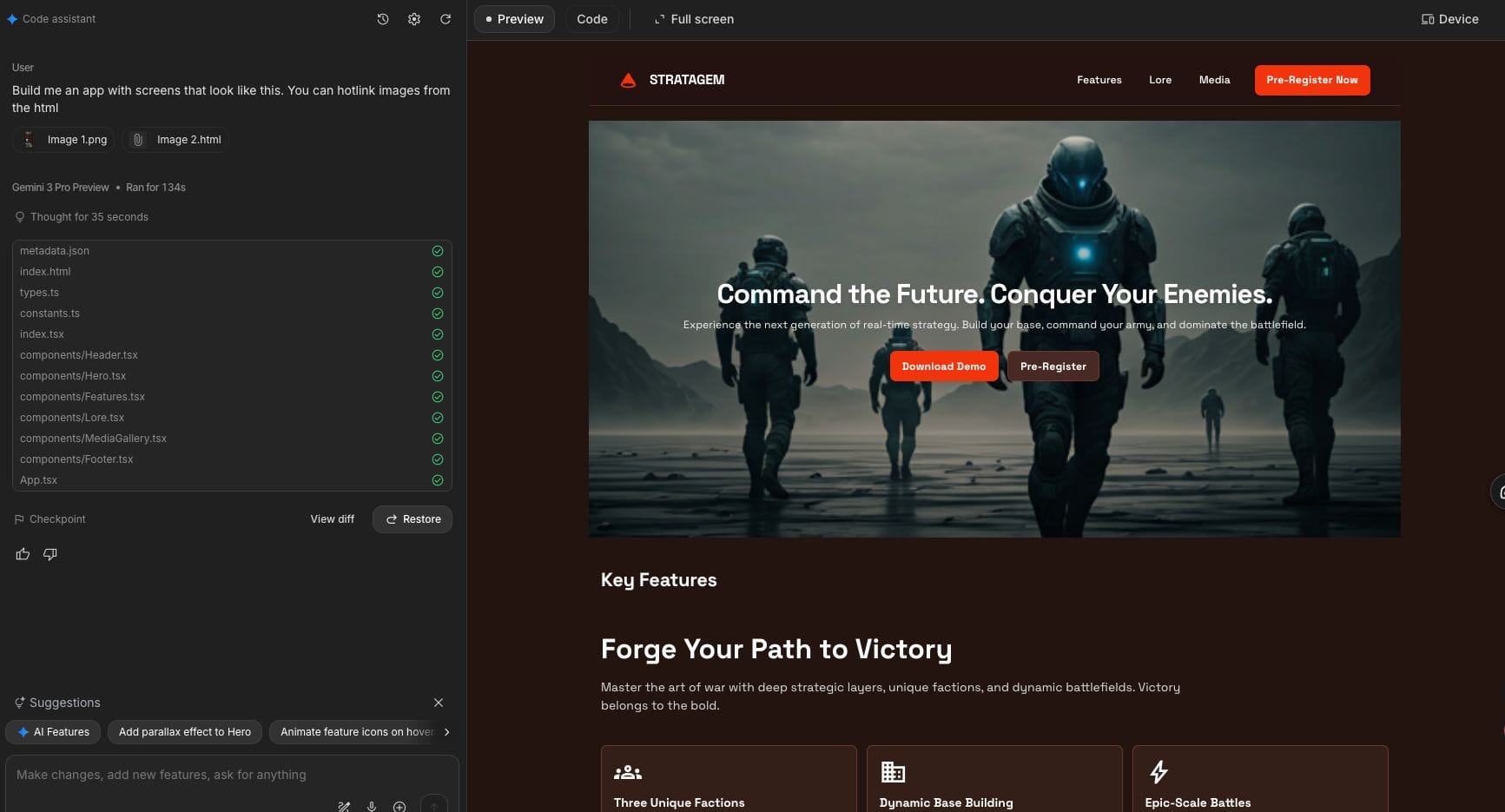Imagine you’ve just finished "painting" a complex landing page for a Real-Time Strategy (RTS) game in your design tool. The visuals are stunning, the layout is precise.
The next second, you press a button.
A few seconds later, a fully functional web page with clean code structure and visuals almost identical to your design appears right in front of you.
This isn't sci-fi. This is happening right now.
I just tested this workflow myself. Work that used to take a frontend engineer hours or even days—slicing assets, writing CSS, debugging layout issues—has been compressed into seconds.
The heroes behind this shift are two tools that have just completed an epic convergence: Stitch and Google AI Studio (Gemini 3).
⚡️ The Final Piece of the Toolchain: Stitch 1-Click Export
For independent developers building web apps, Stitch is likely already on your radar. It’s an incredibly efficient AI-assisted UI design tool. But for a long time, there was friction between "Design" and "Code": you had to manually copy code or drag-and-drop screenshots to an AI, which was tedious and often resulted in lost context.
Today, Stitch officially filled that gap.
Stitch has launched "1-Click Export to AI Studio."

The power of this feature lies in how "frictionless" and "complete" it is:
- Context-Aware: It doesn't just send an image; it automatically bundles your current HTML structure + Screen Context.
- Zero Friction: Say goodbye to manual Ctrl+C/Ctrl+V and dragging images around.
- Ready to Build: Click export, and it instantly wakes up Google AI Studio with all assets in place, ready for Gemini 3 to get to work.
⚠️ Quick Tip: Due to file format updates, this feature works natively on projects created after Nov 15. If you have an older project, just hit "Duplicate" in the menu, and the fresh copy will support it perfectly.
🌊 The Perfect Storm: Gemini 3 Meets Stitch
Why is this the golden age for indie developers? Look at the timeline:
- Yesterday: Google AI Studio leveled up, integrating the planet's most capable model, Gemini 3.
- Today: Stitch ships the 1-Click Export feature.
It’s a match made in heaven. Stitch provides the structured design context, while Gemini 3 offers top-tier multimodal understanding and code generation capabilities.
It’s like having the world’s best architectural blueprints (Stitch) and suddenly hiring an elite construction crew (Gemini 3) to execute them.
Check out the actual result:

The image above shows the RTS game landing page generated by Gemini 3 immediately after exporting from Stitch. The layout, color scheme, and details achieved an astonishing level of fidelity.
🚀 Deep Dive: What Does This Mean for Indie Devs?
For independent developers building global products or web apps, this combination isn't just about "saving time"—it represents a completely new development paradigm.
1. Design is Code
We used to talk about "converting design to code" as a translation process from visual language to programming language, often accompanied by information loss and misinterpretation.
Now, Gemini 3's powerful multimodal capabilities (simultaneously "seeing" the screenshot and "reading" the HTML structure) make this translation nearly transparent. When you tweak a pixel or a border radius in Stitch, the AI captures it precisely and converts it to code. Your design process is, essentially, writing code.
2. The MVP Speed Revolution
When building for global markets, Time to Market is a core competitive advantage.
In the past, validating an idea meant: Design -> Slice -> Frontend Dev -> Style Tweaking. It could take a week. Now? You can have an idea in the morning, prototype it in Stitch by lunch, and deploy it via AI Studio by dinner.
This speed of "shipping ideas" will widen the gap between developers exponentially.
3. Lowering the Full-Stack Barrier
Many indie devs excel at backend logic but get a headache when facing complex CSS; or they are designers who struggle with layout code.
The Stitch + Gemini 3 combo allows someone who doesn't know CSS to build Awwwards-level websites, and allows non-designers to get professional-grade interfaces through simple drag-and-drop and AI refinement. It drastically flattens the technical learning curve for becoming "Full Stack."
🎯 Conclusion
The toolchain is finally seamless.
Google is reshaping the AI ecosystem with Gemini 3, and tools like Stitch are moving fast to translate that capability into productivity.
For us developers, the excuses are running out. Technical barriers are being peeled away layer by layer. The remaining competition returns to the essentials: Your ideas, and your execution in bringing them to life.
Don't hesitate. Go "Duplicate" your old projects, upgrade them, and feel the rush of "one-click to the future." Go build something real, fast.
